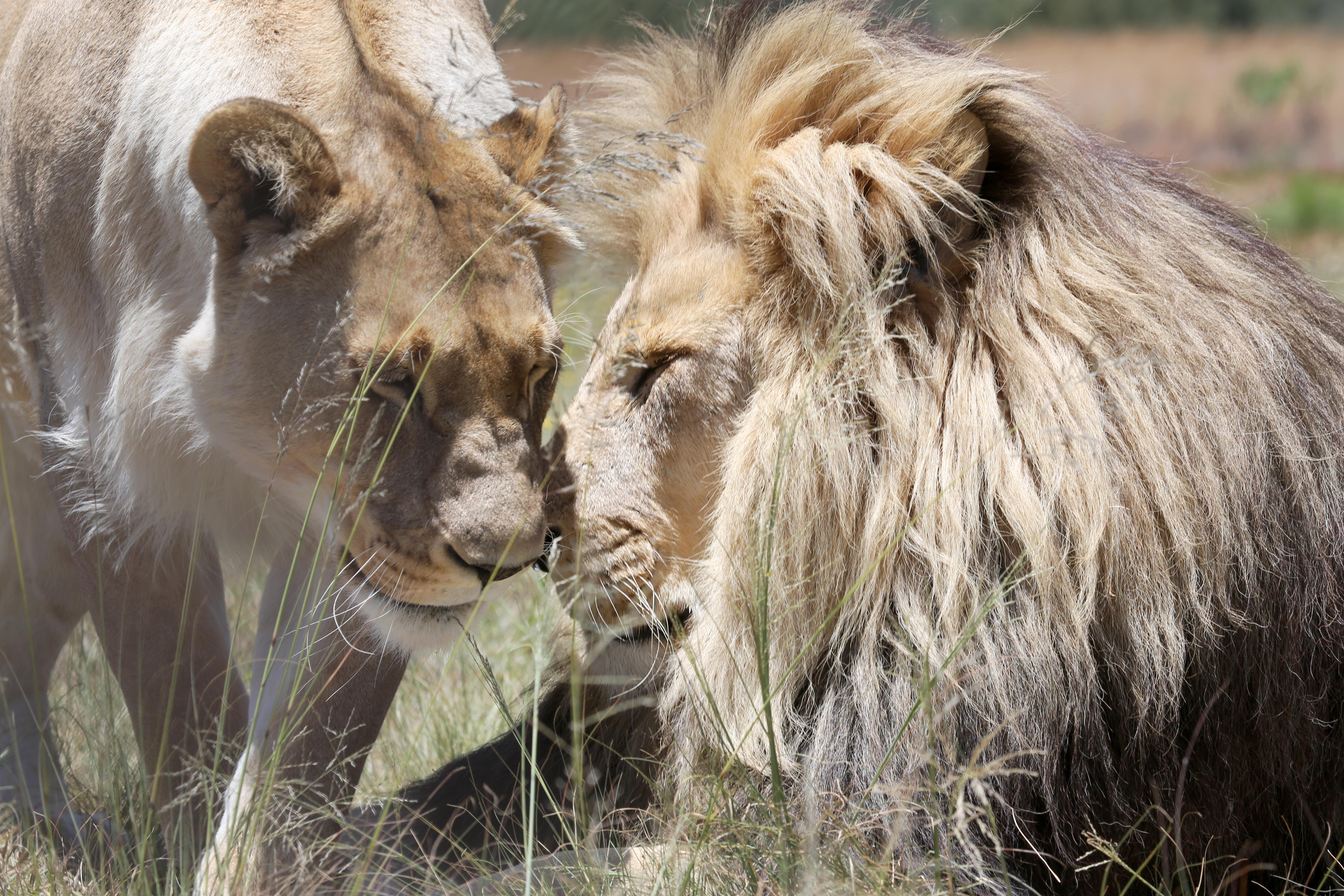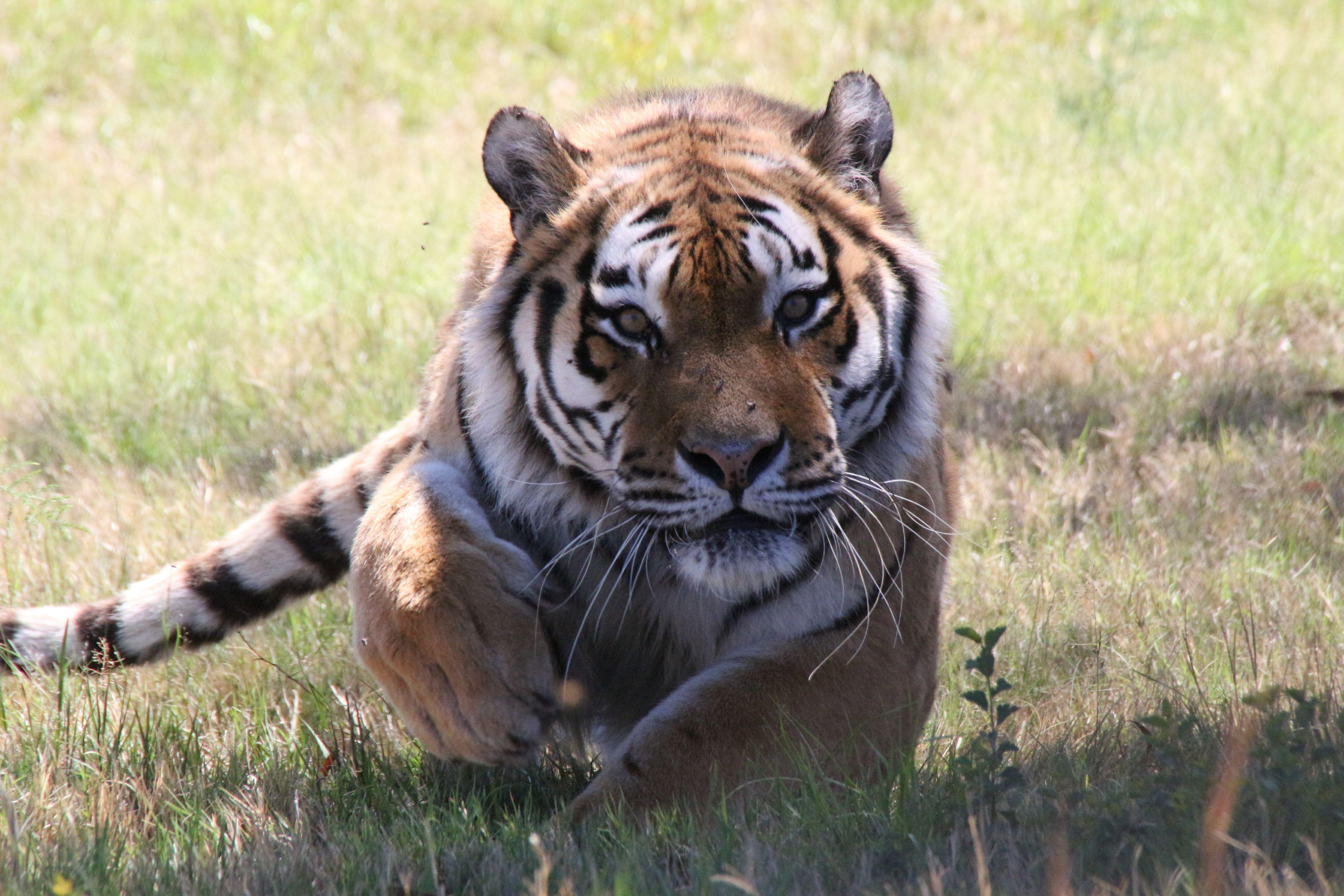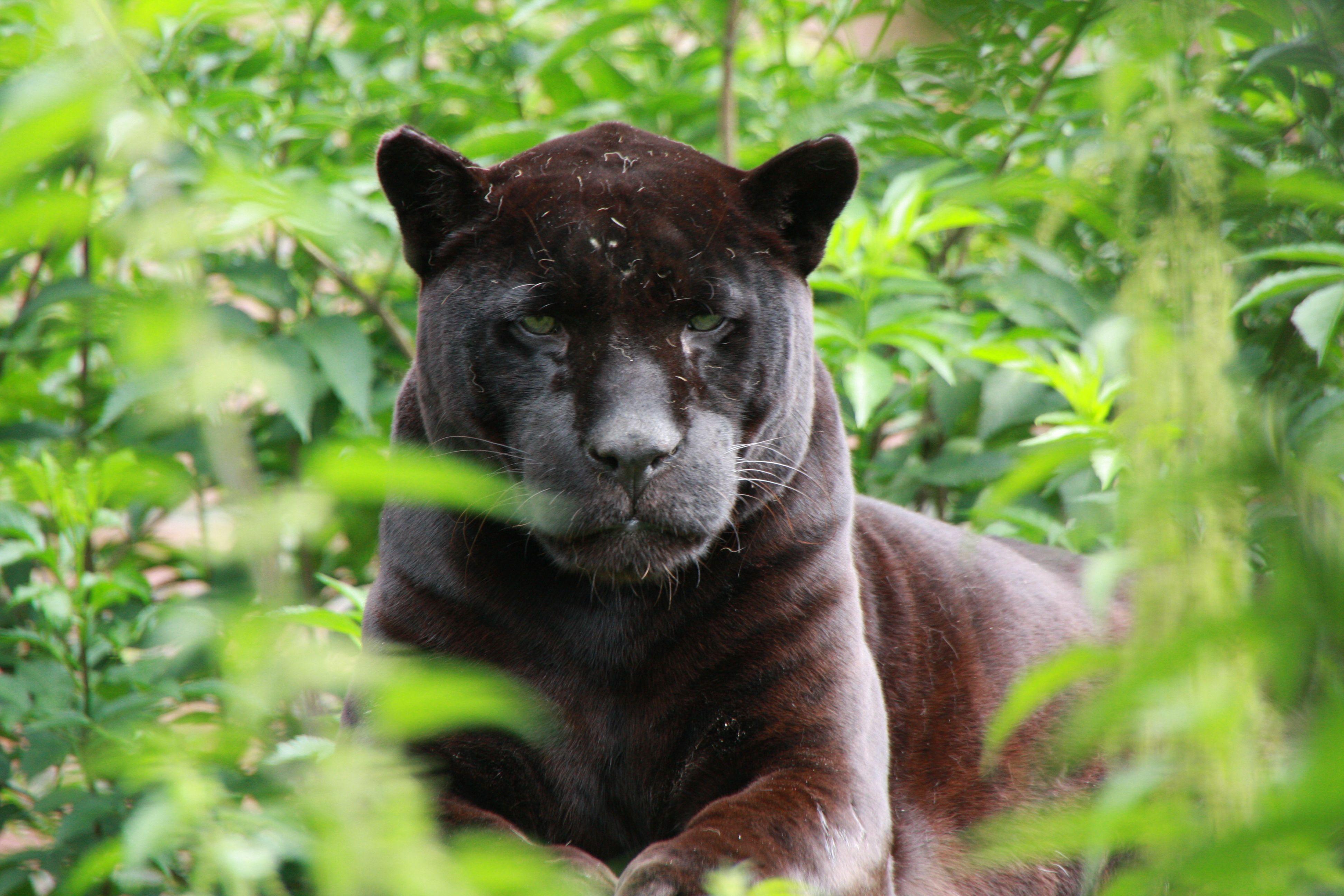
Big cats in the wild
Big cats are wild animals which are all threatened to some extent in the wild
Panthera taxonomy and phylogeny
| Class: | Mammalia (mammals) |
| Order: | Carnivora (carnivores) |
| Family: | Felidae (felines) |
| Genus: | Panthera |
The Felidae family consists of feline predators and can be divided into two subfamilies: the Pantherinae and the Felinae. The Pantherinae family includes the five big cat species, found within the genus Panthera: the lion (Panthera leo), tiger (Panthera tigris), jaguar (Panthera onca), leopard (Panthera pardus) and snow leopard (Panthera uncia). FOUR PAWS focuses on these big cat species.
All the big cat species are declining worldwide. The main threats to big cat populations are habitat loss, human–wildlife conflict, (illegal) wildlife trade and hunting. Wild population numbers would benefit more from habitat protection than from the release of captive big cats into these environments.

A group of lionesses
Lions
The lion (Panthera leo) is the only true social wild big cat and is found in Africa and Asia. Prides typically consists of 1-20 related females, their offspring and 1-9 often related males (average 2-4). The females typically stay within one pride, although the entire pride is rarely all together at once. Pride cohesiveness is dependent on prey availability.
The colour of the coat varies from yellow-brown and grey to orange and dark brown. It is possible to identify individual lions based on their whisker spot pattern.
Some lions have a white coat. These lions are not albino and are not a separate (sub)species but have a recessive mutation that results in the white skin and lighter eyes. White lions exist in the wild in the Greater Kruger in southern Africa, but they are mostly found in captivity. As the mutation is recessive and rare, most captive white lions are inbred, negatively affecting their health and welfare. White lions are often cross-eyed, which is a sign of inbreeding.
Taxonomy and distribution
According to IUCN there are two subspecies:
| P. l. leo (African lion) | The African subspecies is found in 25 African countries, but possible individuals/populations still exist in an additional 7 African countries. |
| P. l. persica (Asiatic lion) | There is only one population of Asiatic lions, which is found in Gir National Park in India. There are plans to introduce this subspecies into Kuno Wildlife Sanctuary, with the intention to protect the subspecies from extinction due to diseases and/or natural calamities. |
Scientists have however proposed a different split into subspecies, which is still being researched. This split includes two subspecies, Panthera leo leo (Asia and West, Central and North Africa), and Panthera leo melanochaita (South and East Africa).
Status
The estimate of the total number of mature lions in the wild is between 23,000 and 39,000 (IUCN), with a global decline of 43% between 1993 and 2014. Most of the lions are found in East and southern Africa. It is believed that they are currently found in 8% of their historic range.
Hunting behaviour
Lions are opportunistic hunters, killing anything they encounter, but they prefer larger herbivores (60-550 kg). They mainly hunt during twilight or during the night. Females do most of the hunting, although when males participate in the hunts, success rate is often increased for larger preys (such as buffalo, giraffe and elephants). Hunting success is typically low, ranging from 15% (Etosha NP, Namibia) to 38.5% (Kalahari). Lions also scavenge, with intake rates as high as 40% (Serengeti NP, Tanzania).
Quick facts
| Maximum life expectancy: | ♀19 years ♂16 years (rarely older than 12 years) |
| Average size: | body ♀158 - 192 cm ♂172 - 250 cm, tail 60 - 100 cm, shoulder height 100 - 128 cm, weight: ♀110 - 168 kg ♂150 - 272 kg |
| Sexual mature: | ♀ 30 - 36 months, but often first give birth at around 42 - 48 months ♂ 26 - 28 months |
| Gestation period; litter size; weaning; dispersal age: | 98 - 115 days; 2 - 4 up to 7; 6 - 8 weeks, but may continue until 8 months; rarely before 2 years |
| CITES: | Appendix I (Asia) & II (Africa) |
| IUCN Red List: | Vulnerable (global); Endangered (India); Critically endangered (West Africa) |
| Population trend: | Decreasing |

The lion (Panthera leo) is the only true social wild big cat and is found in Africa and Asia.
Tiger
The tiger (Panthera tigris) is a solitary big cat species and is known to be the biggest big cat in the wild, although sizes do vary from 140 kg to up to 261 kg. The largest tiger in captivity weighed 325 kg. The basic colour of the coat varies from dark red to pale yellow and the pattern and darkness of the stripes vary. In general, tigers from northern regions are lighter with fewer stripes. The coat is short, except for the thick, long winter fur in far eastern Russian regions. The patterns on the flanks and the head are unique per individual.
Some tigers have a white coat. These tigers are not albino and are not a separate (sub)species but have a recessive mutation that results in the white skin. White tigers are rarely recorded in the wild and are mostly found in captivity. As the mutation is rare and recessive, most captive white tigers are inbred, negatively affecting their health and welfare. White tigers are often cross-eyed, which is a sign of inbreeding.
Taxonomy and distribution
According to IUCN there are nine subspecies, of which three or four are extinct:
| P. t. altaica (Amur tiger) | found in Russian Far East and north-eastern China; Endangered |
| P. t. tigris (Bengal tiger) | found in Indian sub-continent; Endangered |
| P. t. amoyensis (South China tiger) | this species has not been directly observed in the wild since the 1970s, so is possibly extinct; Critically endangered |
| P. t. corbetti (Northern Indochinese tiger) | found in Indochina north of the Malayan Peninsula; Endangered |
| P. t. jacksoni (Malayan tiger) | found in Peninsular Malaysia; Critically endangered |
| P. t. sumatrae (Sumatran tiger) | found in Sumatra; Critically endangered |
| P. t. balica (bali tiger) | used to be in Bali; Extinct |
| P. t. sondaica (Javan tiger) | used to be in Java; Extinct |
| P. t. virgate (Caspian tiger) | used to be in dry river valleys of the Takla Makan, western slopes of the Tianshan mountains, Amudarya and Syrdarya river valleys, shores of the Caspian Sea, Elburz mountains, eastern Turkey, Tigris and Euphrates river valleys; Extinct |
There are however varied opinions regarding the interpretation of the existing data used to divide tigers into the different subspecies. Hence, this taxonomy is currently under review by the IUCN SSC Cat Specialist Group.
Status
The tiger is an endangered big cat species with estimated numbers of 2,608 – 3,905 mature individuals, with the best estimate of 3,140 (IUCN). Tigers used to be found in a wide range of Asian countries, but have disappeared from many of these countries over the past 100 years. This species is now found in less than 7% of their historic range. In addition to habitat loss, tigers are under threat due to poaching for Traditional Medicines and commercial trade.
Hunting behaviour
Tigers are diverse hunters, capable of killing prey up to 1,000 kg in weight. They are opportunistic hunters, killing almost everything they encounter, and hunting activity is mostly at night and during twilight. Tigers are believed to be the large carnivore that kills the most people. This is probably caused by the fact that human populations are very dense in Asia and there are quite a lot of people that use tiger habitat intensively. Tigers also scavenge and steal kills from other predators.
Quick facts
| Maximum life expectancy: | ♀16 years ♂12 years |
| Average size: | body ♀146-177 cm ♂189-300 cm, tail 72-109 cm, shoulder height 80-110 cm, weight ♀75-177 kg ♂100-261 kg |
| Sexual mature: | 2.5-3 years; earliest breeding ♀3 years and ♂ 3.4 years |
| Gestation period; litter size; weaning; dispersal age: | 95-107 days; 2-5; 3-5 months; 17-24 months |
| CITES: | Appendix I |
| IUCN Red List: | Endangered (global) |
| Population trend: | Decreasing |

The tiger (Panthera tigris) is a solitary big cat species and is known to be the biggest big cat in the wild.
Leopard
The leopard (Panthera pardus) is a very tolerant species, which can persist in many different habitats. They are known to be able to survive in high human densities. Additionally, they can cope with extremely cold temperatures (-30 °C in Russian boreal forests) and extremely hot temperatures (70 °C in deserts). Leopards are solitary and extremely territorial.
The coat colour varies from bright golden yellow to pale yellow and rust red yellow, with a white belly. The coat is short with black spots on the head, neck, shoulders, legs and backside. On the side and the back, the black spots form broken circles or rosettes. Melanistic forms, known as black leopards or black panthers, also occur.
Taxonomy and distribution
According to IUCN there are nine subspecies:
| P. p. pardus (African leopard) | Africa |
| P. p. nimr (Arabian leopard) | Arabia |
| P. p. saxicolor (Persian leopard) | Southwest Asia |
| P. p. melas (Javan leopard) | Java |
| P. p. kotiya (Sri Lankan leopard) | Sri Lanka |
| P. p. fusca (Indian leopard) | Indian sub-continent |
| P. p. delacouri (Indochinese leopard) | Southeast Asia into Southern China |
| P. p. japonensis (North Chinese leopard) | Northern China |
| P. p. orientalis (Amur leopard) | Russian Far East, Korean Peninsula and northeastern China |
The taxonomy for P. pardus is currently under review by the IUCN SSC Cat Specialist Group.
Status
The number of leopards globally is unknown, although it is believed that populations are declining. Range declines has been substantial over the past three generations (22.3 years), due to habitat destruction, prey reductions due to the bushmeat trade, illegal harvest, and human-leopard conflict.
For some subspecies there are population estimates available:
- Amur Leopard (P. p. orientalis) - Critically Endangered: < 60
- Arabian Leopard (P. p. nimr) - Critically Endangered: 45-200
- Javan Leopard (P. p. melas) - Critically Endangered: 350-525, with < 250 mature breeding adults
- Sri Lankan Leopard (P. p. kotiya) - Endangered: 700-950
- Persian Leopard (P. p. saxicolor) - Endangered: 800-1,000
Hunting behaviour
Leopards are known to be hunting on various prey items, ranging from small arthropods to large mammals. However, they prefer medium-sized ungulates, such as impala and antelope species. They are also known for hunting primates, birds, dogs and livestock. They can carry prey items of up to 91 kg into trees to prevent other carnivores from stealing it.
Quick facts
| Maximum life expectancy: | ♀19 years ♂14 years |
| Average size: | body ♀95-123 cm ♂91-191 cm, tail 51-101 cm, shoulder height 55-82 cm, weight: ♀17-42 kg ♂20-90 kg |
| Sexual mature: | 24-28 months, with females given birth for the first time at the age of 30-36 months and males first breeding at around 42-48 months |
| Gestation period; litter size; weaning; dispersal age: | 90-106 days; 1-4, rarely to 6; 8-10 weeks and ceased before 4 months; 12-18 months |
| CITES: | Appendix 1 (with existing hunting quotas) |
| IUCN Red List: | Vulnerable (global) |
| Population trend: | Decreasing |

The leopard (Panthera pardus) is a very tolerant species, which can persist in many different habitats.
Jaguar
The jaguar (Panthera onca) is a solitary species. Jaguars are territorial but overlap occurs frequently. The jaguar is the third largest cat in the world, but the largest cat of the Americas. However, sizes vary greatly. Smaller jaguars can be found in Central America, while jaguars double this size can be found in the wet woodland savannah habitats in Venezuela and Brazil. It is the only Panthera species that lives in the New World. The basic colour of the coat varies from pale gold to a rust red and is covered with a series of round dark spots or rosettes with smaller dots within them (unlike leopards). Black (melanistic) jaguars, also referred to as black panthers, are common.
Taxonomy and distribution
There are no known subspecies of jaguars, although this remains to be studied further. Preliminary research has shown that some populations, specifically in Mexico, Guatemala, southern Central America, northern South America, South America south of the Amazon River, are isolated phylogeographically. Additionally, in Colombia, the Andes Mountains isolates, although incompletely, different jaguar populations.
Status
It is unknown how many individuals exist in the wild, but their number is decreasing. The jaguar is believed to be extinct in 51% of its former range and extinct in multiple countries, including for example El Salvador and Uruguay.
Hunting behaviour
The jaguar has a diverse diet, with at least 85 recorded prey species. Compared to other wild cats, jaguars also hunt for reptiles (for example caimans and snakes). Jaguars have proportionally the strongest bite of all big cats.
Quick facts
| Maximum life expectancy: | poorly known from the wild, but thought not to exceed 15-16 years |
| Average size: | body ♀116-219 cm ♂110-270 cm, tail 40-80 cm, shoulder height 68-75 cm, weight: ♀36-100 kg ♂36-158 kg. |
| Sexual mature: | 24-30 months, with females given birth for the first time at the age of 3-3.5 years old |
| Gestation period; litter size; weaning; dispersal age: | 91-111 days; 1-4; 10 weeks, but typically ceases after 4-5 months; 16-24 months |
| CITES: | Appendix I |
| IUCN Red List: | Near Threatened |
| Population trend: | Decreasing |

The jaguar (Panthera onca) is a solitary species. Jaguars are territorial but overlap occurs frequently.
Snow leopard
The snow leopard (Panthera uncia) is a solitary species, found in high mountain habitats. Snow leopards keep a stable large home range, but it is unknown whether this home range is defended as a territory. Snow leopards are adapted to cope with deep snow, rugged terrains and high altitudes. Due to the distribution and habitat use of snow leopards, they are extremely difficult to study and very little is known about this species. The basic colour varies from smoke grey to tan, with a white belly. Covered with dark grey to black open rosettes with small spots of the same colour on the head and larger spots on the legs and tail. Snow leopards have pale green or grey eyes, which is an unusual eye colour for felines. They have a long, thick coat and are smaller than the other big cat species.
Taxonomy and distribution
According to IUCN there are no subspecies of snow leopards. Although not confirmed by genetic analysis, morphological differences show two subspecies. The snow leopard is most closely related to the tiger and is found in 12 different Central Asian countries in the high mountain ranges, including the Altai, Himalayas, Karakoram, Hindu Kush, Pamirs and Tien.
Status
According to IUCN there are between 2,710 and 3,386 mature individuals, although due to the landscape where this species occurs, it is extremely difficult to estimate numbers.
Hunting behaviour
Snow leopards eat both small and large prey species and are incredibly agile over extremely steep and rugged terrain.
Quick facts
| Maximum life expectancy: | presumably 12 years |
| Average size: | body ♀86-117 cm ♂104-125 cm, tail 78-105 cm, shoulder height up to 60 cm, weight: ♀21-53 kg ♂25-55 kg |
| Sexual mature: | unknown |
| Gestation period; litter size; weaning; dispersal age: | 90-105 days; 2-3 cubs up to 5; 2-3 months; 18-24 months |
| CITES: | Appendix I (A) |
| IUCN Red List: | Vulnerable |
| Population trend: | Decreasing |
